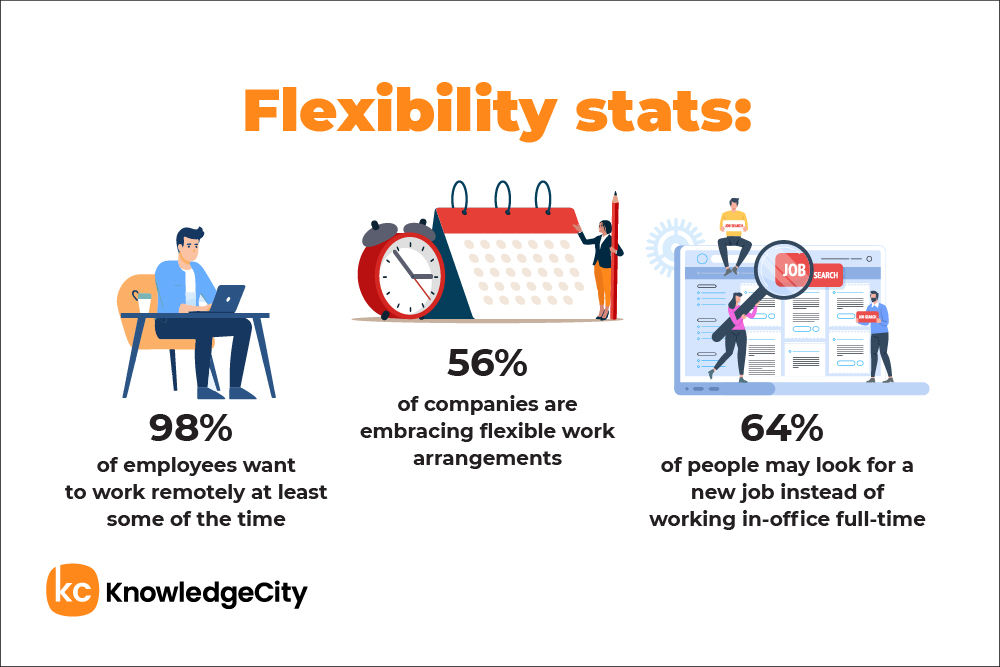Are you thinking about bringing employees back to the office? Tread carefully if you are, because some 68% of employees would consider jumping ship if it meant coming back in.

The business landscape has changed dramatically since the World Health Organization declared that COVID-19 was no longer a public health emergency. In the thick of the pandemic, for around a year and a half, people were essentially forced to complete work-related duties from home or mostly from home.
Though some might have thought that the pandemic winding down would mean a return to how things used to be, that’s not what happened.
What we’re seeing instead is what’s called the Great Reshuffle. It’s a phenomenon where businesses are adopting flexible work models, and workers are looking to maximize their work-life balance. They want to chase employment opportunities that mesh with their beliefs and values.
In fact, per a recent ADP survey, 64% of participants stated that they would look for other job opportunities if they were required to work in the office full-time.
If you’re an HR decision-maker or training and development manager, it’s essential to be at the forefront of workplace flexibility. This article will look at what flexible work is, why it’s important, flexible work benefits, and strategies you can implement to leverage it at your firm.
What Is Flexible Work?
As we emerge from the worst of the pandemic, more and more people are looking into flexible work opportunities. But what exactly does this mean? Flexible work doesn’t have an all-encompassing definition. It may mean different things to different workers, managers, and organizations.
In general, it refers to working arrangements or business opportunities where employees don’t have to abide by the rigid structure of a traditional job. Instead, they have some degree of control over when and where they work.
One of the most common types of flexible work is working partially or fully from home. Employees may work two days at home and three days in the physical office, for example. Still, flexible work may look slightly different from one case to the next.
Why Is Flexibility Important in the Workforce?
Flexibility is essential in the workforce, and there’s an overwhelming amount of evidence pointing to this fact. Here are a few stats that support this:
Strong interest in remote work among employees. According to Buffer, a staggering 98% of employees want to work remotely at least some of the time. There’s major interest among employees to work in a more flexible manner.
Companies are getting on board. Around 56% of companies are beginning to embrace flexible work arrangements. That is, they’re looking to offer hybrid, flexible, and remote work in the future.
As an increasing number of employers jump on the flexibility bandwagon, those companies that fail to adapt may find it hard to secure quality talent. The majority of business leaders believe that giving employees this flexibility will be good for both people and businesses.
There’s a need to cater to multi-generational workforces. There are multiple generations of people working at any given company, and they have different wants and needs regarding employment.
Some people are part of those 68% who would consider finding a new job instead of returning to the office. Then there are employees who are just entering the workforce and prefer to be in-person for social interaction. Flexibility in employment arrangements is necessary to adequately support individuals’ work-related desires.
The Benefits of Flexible Work
Another reason that flexible work is important is that it carries some promising benefits for both employees and their employers.
Improved Productivity Among Employees
Some may think that giving employees more flexibility could result in a dip in productivity. This is rarely the case.
Qualtric’s The Future of Work in 2021 report found that, during the pandemic, when most businesses were forced to allow employees to work flexible schedules, productivity improved.
Fifty-five percent of employees were more productive while working remotely than they were in the office. Twenty-nine percent were about as productive working remotely as they were working in the office. Only 16% of employees were less productive working remotely than in the office.
This study demonstrates that flexible work that concerns working from home can, and often does, result in increased productivity.
Larger Talent Pools for Employers
The biggest asset for any company is its employees, and that’s why securing top talent is crucial. When businesses offer flexible work opportunities for employees, they can gain access to a larger talent pool.
For instance, when an employer only allows for in-person work, their candidate pool becomes limited by geographical location. You can only consider candidates who live at a close enough distance to commute regularly to a physical office or are willing to relocate.
When you open up your talent pool by allowing more flexibility, you get to consider and potentially hire candidates who have the skills and talent your company needs to succeed. At that point, geographical location becomes less of an issue.
Happier Employees
Workforce flexibility has a positive effect on employees’ output and well-being. Depending on the type of work arrangement they’ve taken on, they often appreciate not having to make regular commutes to an office, sleeping in, and being able to cook more meals from the comfort of their own home.
They also appreciate that they’re often able to take a longer lunch. It’s an opportunity to reset, have some refreshments, and get a little more time to themselves.
This benefit also applies to employers, seeing as how unhappy employees can have a severe impact on profitability. So, making your employees happy with workplace flexibility can bode well for your company.
Employees Love Not Commuting
According to a 2021 press release from the United States Census Bureau, the average travel time to work was 27.6 minutes one-way in 2019. The average worker will spend nearly an hour sitting in a car driving either to or from work in a day. These hours add up over the days, weeks, and months.
Also, remember that this is only an average. Some people must drive for much longer to travel to work.
Many of those who work from home at least a portion of the time get to skip the commute and spend that time doing other things. They may sleep in, spend more time connecting with others, cook breakfast, de-stress, or whatever else they want to do.
These employees are more likely to have a positive attitude toward work. According to a study conducted by Tracking Happiness, the ability to work remotely increased employee happiness by up to 20%. The study also found that the further an employee lives from their workplace, the more unhappy they may be.
Employee Money Savings
Another way that employers benefit from the implementation of flexible work strategies is by saving money. According to Global Workplace Analytics, employers who switch over to remote work can save a total of about $11,000 per employee. These savings come from not having to provide physical infrastructure, pay for utilities, and cover other resources related to running a physical office.
Such savings can be instrumental in increasing profits and staving off collapse for businesses in precarious financial positions.
Choice in the Workplace
The element of choice carries much weight in the workplace; employees should be able to decide how and when they work. There are several reasons why this is the case.
First, most employees want to be able to work and have a home life that’s fulfilling for them. They’re not afraid to fight for this by looking for another company that will provide them with that option.
Remember, 62% of employees would consider leaving a company that doesn’t offer flexible work options for another firm. This should bother companies that don’t provide such opportunities to employees and prompt them to look into ways to provide them with more freedom. Doing so will decrease the chances of employees leaving for this specific reason.
Additionally, implementing choice-based initiatives in the workplace is a great way to craft a happier workforce and more likely to apply themselves to their work. This can translate to enhanced productivity and more profit for the business.
In addition, it often means that people feel better about their place in the company, breeding loyalty and commitment as a result. Workers need some measure of autonomy and control so they can perform well.
Finally, employers are already heading up and pushing initiatives to provide employees with the autonomy they need. With some companies delivering on choice and others failing to, there’ll be competition for quality candidates.
Given the trend toward candidates searching for choice-conscious employers, those companies that ignore candidates’ wants and needs about choice could be left in the dust.
Flexible Workforce Strategies
Let’s look at some of the best workforce strategies that you can implement in your organization concerning flexible work.
Remote Work (Telecommuting)
Employees are allowed to work off-site, usually at home. Giving employees this opportunity requires quite a bit of work on the employer’s part. Since managing employees in person won’t be possible, it must be done virtually.
You’ll have to work overtime to build connections within your teams, which is much harder to do in a remote arrangement than an in-office one. In addition to that, look for ways your remote workers can collaborate with their colleagues to foster teamwork.
It’s also essential to leverage technology to facilitate onboarding, conduct meetings, troubleshoot issues, and increase productivity. Some of the most helpful technologies include:
- Video-conference applications
- HR software
- Communication software
- Reward systems
Ensure that your remote work policies are complete and easy to understand. They should also be relevant to your company and team, as well as personalized to the specific employee. This will enable you to include heavily detailed, role-specific information. Be sure to draft a remote work agreement for each remote employee to foster individual accountability and address any employee nuances.
Compressed Work Week
You may opt to allow some or all employees to work a compressed work week, which enables workers to work a 40-hour work week in less than five days. This is often seen in professions like firefighting and healthcare.
Employees may work four 10-hour days or three 12-hour days. Employees often prefer this type of work arrangement instead of traditional full-time work to enjoy an extra one or two days per week of leisure.
Flextime
Flextime gives employees the freedom to choose their workday start and end times. To make it to a doctor’s appointment in the morning, an employee who normally works from 9:00 a.m. to 5:00 p.m. may opt to work from 12:00 p.m. to 8:00 p.m. instead. Employees like this type of work arrangement because it allows them to make more time for the things that matter in life.
Hybrid
Hybrid work is a blend of in-person and remote work. It’s used when an employee occasionally goes to the office, but they can still work from home in some capacity. One of the most common hybrid work arrangements allows for a few days in the office and the remainder of the week working from home. Employers should craft a unique hybrid work arrangement that works for their teams and overall goals.
When adopting such a flexibility strategy, it’s important to be open to the changing business landscape and not be afraid to experiment. Also, it’s ideal to focus on the work being completed and the results of such work versus the amount of time spent completing tasks.
There’s no way around it; the future of work is flexible. As an HR decision-maker or a training and development manager, it’s much better for you to be proactive rather than reactive. Don’t wait for negative outcomes to set in, such as turnover, difficulty finding quality talent, or other adverse factors.
Employing empathetic leadership strategies, like workplace flexibility, can spell success for your organization.
Subscribe to Our Newsletter
Join 80,000+ Fellow HR Professionals. Get expert recruiting and training tips straight
to your inbox, and become a better HR manager.

 Andrea Reyes | Staff Writer
Andrea Reyes | Staff Writer 
